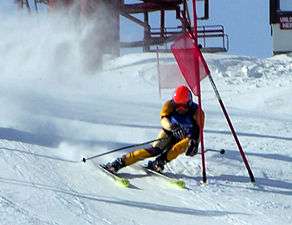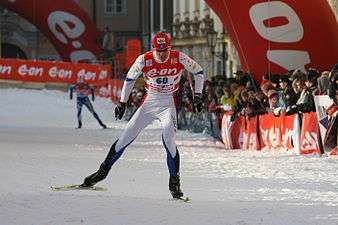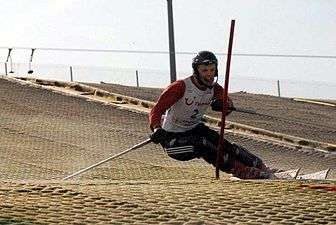Skiing

Skiing is a mode of transport, recreational activity and competitive winter sport in which the participant uses skis to glide on snow. Many types of competitive skiing events are recognized by the International Olympic Committee (IOC), and the International Ski Federation (FIS).
History

Skiing has a history of almost five millennia.[1] Although modern skiing has evolved from beginnings in Scandinavia, it may have been practiced as early as 600 BC in what is now China.[2][3]
The word "ski" is one of a handful of words Norway has exported to the international community. It comes from the Old Norse word "skíð" which means "split piece of wood or firewood".[4][5]
Asymmetrical skis were used at least in northern Finland and Sweden until the late 19th century. On one leg the skier wore a long straight non-arching ski for sliding, and on the other a shorter ski for kicking. The bottom of the short ski was either plain or covered with animal skin to aid this use, while the long ski supporting the weight of the skier was treated with animal fat in similar manner to modern ski waxing.
Early skiers used one long pole or spear. The first depiction of a skier with two ski poles dates to 1741.[6]
Until the mid-19th century skiing was primarily used for transport, and since then has become a recreation and sport.[7] Military ski races were held in Norway during the 18th century,[8] and ski warfare was studied in the late 18th century.[9] As equipment evolved and ski lifts were developed skiing evolved into two main genres during the late 19th and early 20th century, Alpine and Nordic.
Types of skiing
Alpine
Also called downhill skiing, alpine skiing typically takes place on a piste at a ski resort. It is characterized by fixed-heel bindings that attach at both the toe and the heel of the skier's boot. Because alpine equipment is somewhat difficult to walk in, ski lifts, including chairlifts, bring skiers up the slope. Backcountry skiing can be accessed by helicopter, snowcat, Hiking, and now a days Snowmobile. Facilities at resorts can include night skiing, après-ski, and glade skiing under the supervision of the ski patrol and the ski school. Alpine skiing branched off from the older Nordic skiing around the 1920s, when the advent of ski lifts meant that it was not necessary to walk any longer. Alpine equipment specialized to where it can only be used with the help of lifts.
Nordic

The Nordic disciplines include cross-country skiing and ski jumping, which share in common the use of binding that attach at the toes of the skier's boots but not at the heels. Cross-country skiing may be practiced on groomed trails or in undeveloped backcountry areas. Ski jumping skiing is practiced at certain areas that are deemed for ski jumping only.
Telemark
Telemark skiing is a ski turning technique and FIS-sanctioned discipline. It is named after the Telemark region of Norway. Using equipment similar to nordic skiing, the ski bindings having the ski boot attached only at the toe. This allows the skier to raise his/her heel throughout the turn.
Competition
The following disciplines are sanctioned by the FIS and USSA. Many have their own world cups and are in the winter olympics.
- Cross-country: The sport encompasses a variety of formats for cross-country skiing races over courses of varying lengths. Such races occur over homologated, groomed courses designed to support classic (in-track) and free-style events, where the skiers may employ skate skiing. It also encompasses cross-country ski marathon events, sanctioned by the Worldloppet Ski Federation, and cross-country ski orienteering events, sanctioned by the International Orienteering Federation, and biathlon a combination of cross-country and shooting.
- Ski jumping: contested at the olympics, the FIS Ski Jumping World Cup, the summer FIS Grand Prix Ski Jumping, and the FIS Ski-Flying World Championships
- Nordic combined: contested at the olympics and at the FIS Nordic Combined World Cup, it is a combination of cross-country skiing and ski jumping.
- Alpine skiing discliplines include combined, downhill, slalom, giant slalom, Super-G, and Para-alpine there are also combined events that include two event. One run of each even like one run of Super-G and one run of Slalom skiing this is called a Super Combined.
- Freestyle skiing: includes mogul skiing, aerials, ski cross, half-pipe, and slopestyle.
- Snowboard competition includes slopestyle, cross, half-pipe, alpine, parallel slalom, and parallel giant slalom.
Other competition includes grass skiing and Telemark.
- Skiboarding: consists of a combination of skiing and snowboarding. It uses ski boots with a snow board.
Equipment

Equipment used in skiing includes:
- Skis, which may have skins applied or be textured for uphill traction or wax applied for minimizing sliding friction. Twin-tip skis are designed to move forwards or backwards.
- Boots and bindings
- Poles
- Helmets and ski suits
- Ski goggles
Technique
Technique has evolved along with ski technology and ski geometry. Early techniques included the telemark turn, the stem, the stem Christie, snowplough, and parallel turn.
New parabolic designs like the Elan SCX have enabled the more modern carve turn.
Skiing without snow
Originally and primarily a winter sport, skiing can also be practiced indoors without snow or outdoors on grass, on dry ski slopes, with ski simulators, or with roller skis.
Gallery
-

Giant Slalom Ski Racer
-

Freestyle switch 720 mute grab
-

A ski jumper using the V-style
-

Cross country skiing: Priit Narusk in the qualification for the Tour de Ski in Prague.
-

Dry slope racing
-

A skier with a disability on a sit-ski, using two outriggers.
See also
References
- ↑ Formenti; et al. (2005). "Human locomotion on snow: determinants of economy and speed of skiing across the ages" (PDF). Proc. R. Soc. B. Retrieved 2016-09-02.
- ↑ Editors (January 25, 2006). "Ancient paintings suggest China invented skiing". China Today. Xinhua News Agency. Retrieved 2015-01-27.
- ↑ Marquand, Edward (March 15, 2006). "Before Scandinavia: These could be the first skiers". Christian Science Monitor. Retrieved 2015-03-08.
- ↑ The cradle of skiing (Norway – the official site in the United States)
- ↑ Skiing and the Creation of a Norwegian Identity (Norway – the official site in the United States)
- ↑ Hergstrom, P (1748). Beschreibung von dem unter schwedischer Krone gehörigen Lappland. Leipzig: von Rother.
- ↑ Saur, Lasse (1999): Norske ski - til glede og besvær. Research report, Høgskolen i Finnmark.
- ↑ Bergsland, Einar (1946): På ski. Oslo: Aschehoug.
- ↑ "How concern for the national health and military preparedness led France to build the infrastructure for Chamonix, 1924.". Retrieved 17 July 2014.
![]() Media related to Skiing at Wikimedia Commons
Media related to Skiing at Wikimedia Commons